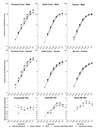Sex disparities in colorectal cancer incidence by anatomic subsite, race and age
- PMID: 20503269
- PMCID: PMC3031675
- DOI: 10.1002/ijc.25481
Sex disparities in colorectal cancer incidence by anatomic subsite, race and age
Abstract
Although incidence of colorectal cancer (CRC) in the United States has declined in recent years, rates remain higher in men than in women and the male-to-female incidence rate ratio (MF IRR) increases progressively across the colon from the cecum to the rectum. Rates among races/ethnicities other than Whites or Blacks have not been frequently reported. To examine CRC rates by sex across anatomic subsite, age and racial/ethnic groups, we used the National Cancer Institute's Surveillance, Epidemiology and End Results (SEER) program for cases diagnosed among residents of 13 registries during 1992-2006. Incidence rates were expressed per 100,000 person-years and age-adjusted to the 2000 US Standard Population; MF IRR and 95% confidence intervals were also calculated. Among each racial/ethnic group, the MF IRR increased fairly monotonically from close to unity for cecal cancers to 1.81 (Hispanics) for rectal cancers. MF IRRs increased with age most rapidly for distal colon cancers from <1.0 at ages <50 years to 1.4-1.9 at older ages. The MF IRR for rectal cancers also rose with age from about 1.0 to 2.0. For proximal cancer, the MF IRR was consistently <1.5; among American Indian/Alaska Natives, it was <1.0 across all ages. The MF IRRs for CRC vary markedly according to subsite and age but less by racial/ethnic group. These findings may partially reflect differences in screening experiences and access to medical care but also suggest that etiologic factors may be playing a role.
Copyright © 2010 UICC.
Conflict of interest statement
Figures
References
-
- Jemal A, Siegel R, Ward E, Hao Y, Xu J, Thun MJ. Cancer statistics, 2009. CA: a cancer journal for clinicians. 2009;59:225–249. - PubMed
-
- Cheng X, Chen VW, Steele B, Ruiz B, Fulton J, Liu L, Carozza SE, Greenlee R. Subsite-specific incidence rate and stage of disease in colorectal cancer by race, gender, and age group in the United States, 1992–1997. Cancer. 2001;92:2547–2554. - PubMed
-
- Devesa SS, Chow WH. Variation in colorectal cancer incidence in the United States by subsite of origin. Cancer. 1993;71:3819–3826. - PubMed
-
- Irby K, Anderson WF, Henson DE, Devesa SS. Emerging and widening colorectal carcinoma disparities between Blacks and Whites in the United States (1975–2002) Cancer Epidemiol Biomarkers Prev. 2006;15:792–797. - PubMed
-
- Perdue DG, Perkins C, Jackson-Thompson J, Coughlin SS, Ahmed F, Haverkamp DS, Jim MA. Regional differences in colorectal cancer incidence, stage, and subsite among American Indians and Alaska Natives, 1999–2004. Cancer. 2008;113:1179–1190. - PubMed
Publication types
MeSH terms
Grants and funding
LinkOut - more resources
Full Text Sources
Medical
Molecular Biology Databases


